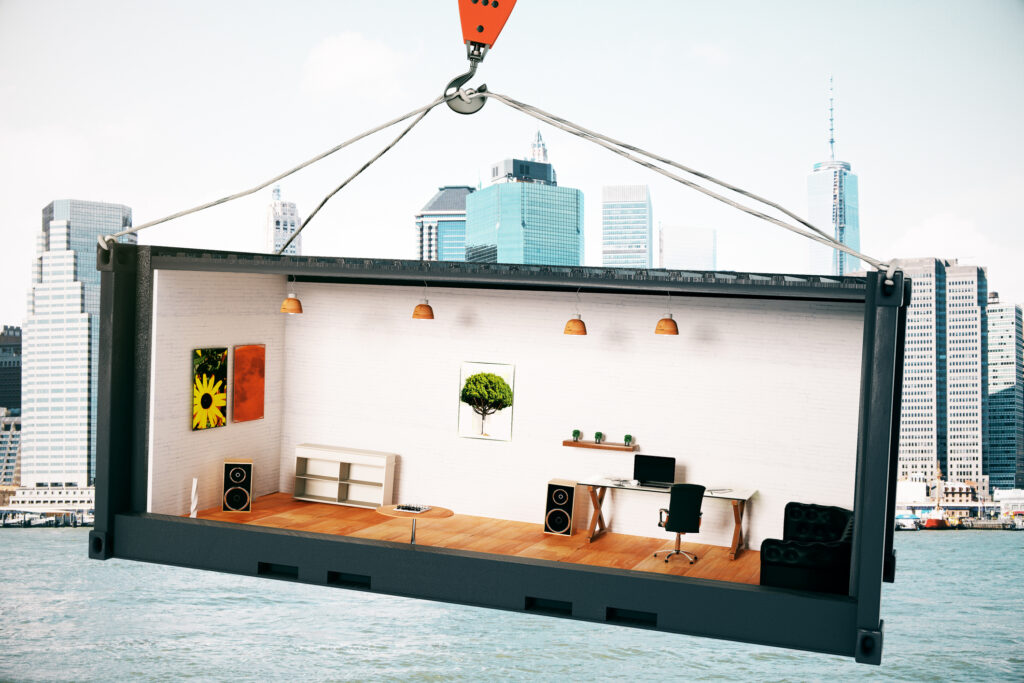
The idea of using a shipping container as an office is nothing new, but it’s certainly gained in popularity in the last year or so with more people working from home. Creating a home office out of a shopping container is ingenious – it’s affordable, mobile, and temporary if you need it to be. Plus, containers can fit in tight spaces in your backyard or even on a construction site – wherever you need to set up shop.
Whether you’re a real estate agent, construction foreman, or consultant, you can save a ton of money on rentals for a larger commercial space. The best part is, you get plenty of privacy from your family or other co-workers, while still maintaining a professional impression when you need to host clients.
When setting up your shipping container office, consider these four tips.
1. Fully Equip Your Container
When you buy a basic shipping container, it will have no frills. So in order to maximize efficiency and minimize how much time and money you spend outfitting your office with what you need, order your container fully equipped with heating, cooling and electrical outlets, as well as optional features like desks, tables, shelving, and filing cabinets.
2. Consider Extras
Many providers offer full customization options to their clients, especially in regard to HVAC and plumbing system installation. You’ll need these if you plan to use the office year-round. In the Northeast, you know how cold it can get in the winter and how stuffy and hot it can get in the summer. HVAC is essential for a fully-functioning office that you plan to use for many hours per day. Plumbing is also essential, especially if you will be having clients in your office on a regular basis.
When outfitting just one container, a sole AC window unit may suffice, but you will need central AC and heat if you plan to purchase a few containers and string them together.
3. Install Large Windows
Because shipping containers are just big boxes, natural light will be hard to come by unless you make a concerted effort to add the proper lighting. This is especially important if you will be inspecting lots of blueprints, plans and other documents. Installing extra windows or larger windows will help to encourage the most natural light during the day. This will add to your overall mood as well as provide a functional purpose, and boost morale and productivity among employees.
If you need light for night time, consider installing LED lights, as they give off light without the heat. In the same vein, you’ll want to add as much ventilation as possible to circulate air and promote good indoor air quality.
4. Increase Storage Space
Storage space in a shipping container office is pretty hard to come by, but that doesn’t mean you’re at the mercy of the small space. You can sacrifice other elements such as large tables and seating areas and install storage units and cabinets instead. This may be important to you if you store a lot of documents, equipment, and supplies. You could also add a few shelves or over-head cabinets to utilize more of your available floor space.
Frequently Asked Questions About Setting Up a Shipping Container Office
What are the benefits of shipping container offices?
Shipping container offices come with several advantages:
- Cost-Efficiency: They’re almost always less expensive than traditional office constructions.
- Eco-Friendly: Repurposing containers reduces waste and encourages sustainable building practices.
- Modularity: Containers can be easily combined or reconfigured to match evolving space needs.
- Quick Setup: With the right planning, they can be transformed faster than building a conventional office.
- Mobility: They can be relocated, offering business location choice flexibility.
How do you make an office out of a shipping container?
To transform a shipping container into an office:
- Planning: Design the layout, considering functionality and comfort as you work.
- Modifications: Cut openings for doors, windows, and ventilation.
- Insulation: Insulate walls, ceiling, and floors to regulate temperature.
- Utilities: Install electrical, internet, and, if needed, plumbing connections.
- Interior: Set up a workspace, seating, lighting, storage, and other necessary office elements.
- Exterior: Paint or clad the container for aesthetics and added protection.
How much does it cost to deliver a container?
The delivery cost for a container depends on the distance, mode of transport, and our rates. On average, for local deliveries spanning 50-100 miles, costs may range from $100 to $500. Our prices may increase significantly for longer distances.
How much does it cost to transport a 20ft container?
The cost to transport a 20ft container varies depending on multiple factors, including the total distance and route complexity. For domestic road transport, prices may range from $1 to $2.50 per mile.
Contact Aaron Supreme
Here at Aaron Supreme, we offer a variety of shipping containers for office use. To get a free quote and to learn more, contact us at 800-243-0403.
